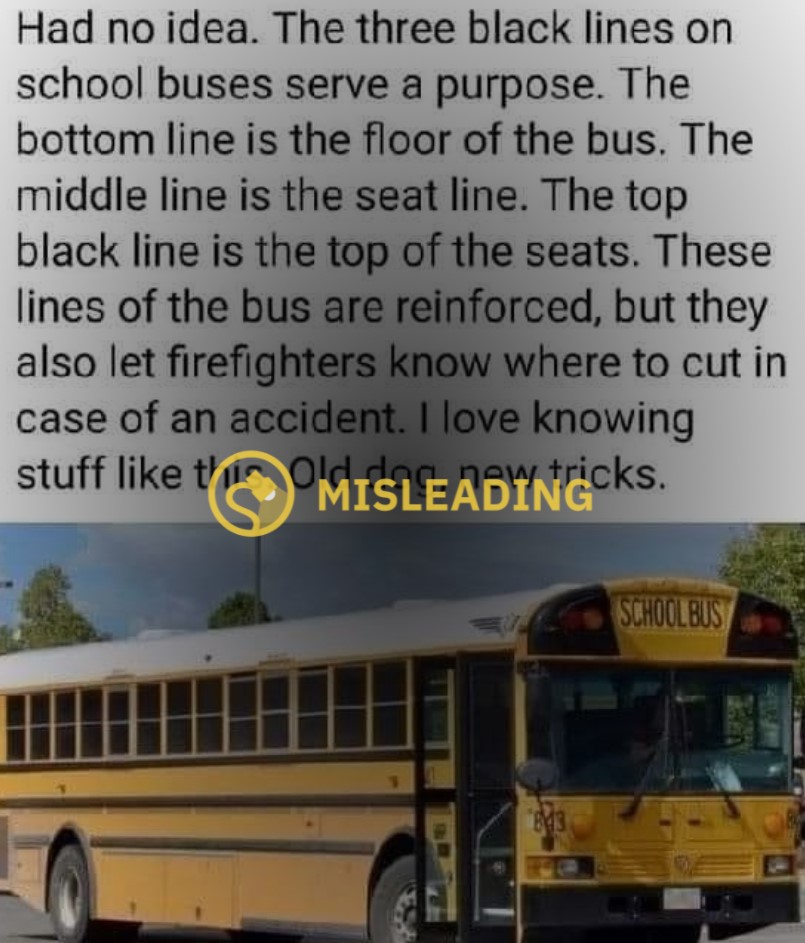In August 2021, an old rumor was recirculated on social media in the form of a meme that claims that the three black lines on the side of a school bus have an unusual purpose: to indicate where the floor and the seats were positioned inside the bus to help emergency crews in the case of an accident:
This rumor has gone viral several times over the years. In March 2021, for example, a video from school bus enthusiast “ClawBoss” racked up nearly 4 million views.
The YouTuber said:
“So here’s something you probably didn’t even know. If you look at school busses all over the country, they all have these black rails. What are they for? Well if you look at where they are placed on a school bus, they actually tell you something: Floor line, bottom of seat, top of the seat.” Not only do these add structure to the side of the bus, so if the bus gets hit it’s stronger. But in the event of an accident, they actually give firefighters an idea of where to cut.”
Many school busses do have stripes on the side of the bus, called “rub rails,” and generally speaking, these stripes tend to line up with the floor level and seat levels inside. However, the primary purpose of rub rails is to add structure to the bus, and their precise location varies from bus to bus. While they can provide a general idea of where the floor and seats are from outside the bus, these are not exact measurements, and we have not seen any evidence that emergency crews truly rely on these stripes during an accident.
A spokesperson for American school bus manufacturer Blue Bird told us:
At Blue Bird, the intended design of a rub rail is actually part of the structural integrity of a school bus. They are there so that buses can meet crash test and other safety requirements. Not all rub rails are black- sometimes they are yellow like the bus, or another color!
Emergency services have adopted this method that you mention later in their production – they use them as markers to determine where the seats are located.
They are required on all school buses per national school bus safety standards.
While rub rails are required per national school bus safety standards, manufacturers are not required to precisely align these stripes precisely with any interior equipment.
A 2010 report from The National Congress on School Transportation notes that there is some leeway when positioning these rails. The middle rub rail, for example, is placed within eight inches of the seat level. The lower rub rail is placed within 10 inches of the floor line.
A.) There shall be one rub rail on each side of the bus located at, or no more than eight inches above, the seat cushion level. They shall extend from the rear side of the entrance door completely around the bus body (except at the emergency door or any maintenance access door) to the point of curvature near the outside cowl on the left side.
B.) There shall be one additional rub rail on each side located 10 inches or less above the floor line. The rub rail shall cover the same longitudinal span as the upper rub rail, except at the wheel housing, and it shall extend only to the longitudinal tangent of the right and left rear corners.
C.) Rub rails above the floor line shall be attached at each body post and at all other upright structural members.
D.) Each rub rail shall be four inches or more in width in its finished form and shall be constructed of 16-gauge metal or other material of equivalent strength suitable to help protect body side panels from damage. Rub rails shall be constructed in corrugated or ribbed fashion.
Jalopnik found similar guidelines from the North Carolina Department of Transportation. These guidelines, too, noted that the “approximate” location for these rails: “Guardrails shall be located at the following approximate locations: floor level, seat level, and windowsill level.”
While these stripes generally line up with the floor and seat, they are not exact indicators of any interior equipment, which gives us pause about the claim that these stripes are used in emergency situations. We reached out to various firefighting departments for more information about their training and we will update this article accordingly. As it stands, however, we have not been able to find any training material, news reports, interviews, etc… mentioning that emergency crews use these stripes during accidents.
Interestingly, this rumor was addressed in another Youtube video from the Miss Hood’s School Bus Life channel. While this channel initially posted a video claiming that these stripes were designed to line up with the floor and seats inside the bus, they posted a follow-up video emphasizing that the true purpose of the rub rail was to add stability to the bus:
While rub rails may provide a general idea of where the seats are placed, these are not specific markings to indicate the position of the floor and seats inside the bus. The primary purpose of a rub rail is to add structure and stability to a school bus.
"bus" - Google News
August 21, 2021 at 10:07PM
https://ift.tt/3sz541c
What Are the Black Lines on a School Bus For? - Snopes.com
"bus" - Google News
https://ift.tt/2rp2JL3
https://ift.tt/3aT1Mvb
Bagikan Berita Ini















0 Response to "What Are the Black Lines on a School Bus For? - Snopes.com"
Post a Comment